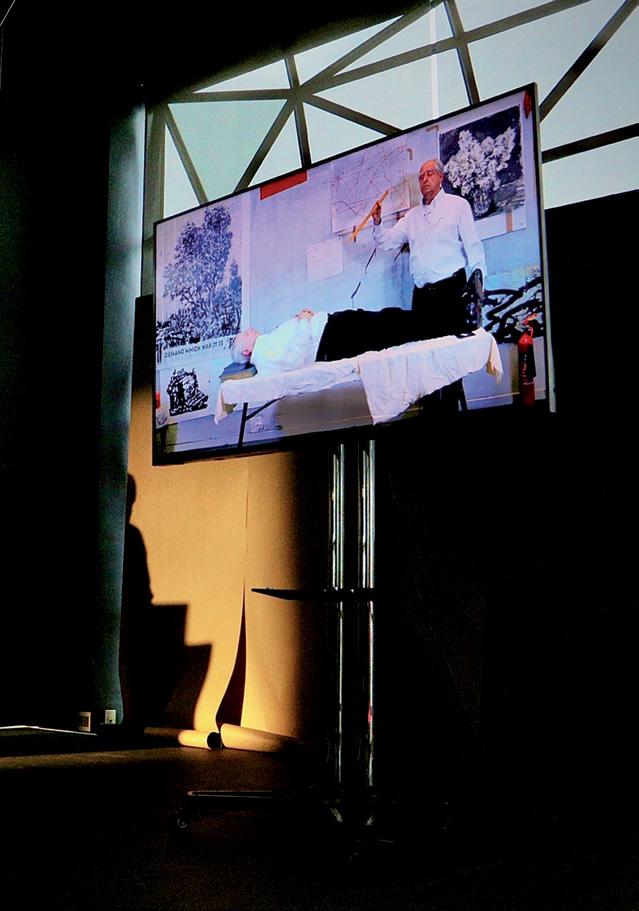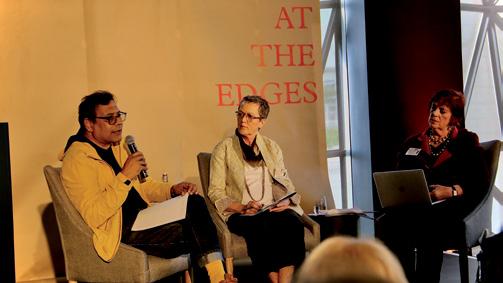
8 minute read
ASHRAF JAMAL COLUMN, ART TIMES

M.O.L.4 DAY IN THE LIFE OF WILLIAM KENTRIDGE Ashraf Jamal Images Courtesy of Zeitz Mocca
Advertisement

The occasion and day in question – the Kentridge Symposium, Sunday 27 October at Zeitz MOCAA – began dramatically when the glass panel of a flatscreen smashed to smithereens on the black stage. With a front row seat, I saw no startled heads though felt my own snap in shock. The two men hoisting the cumbersome screen onto the stage remained calm while I, agog, marvelled at the spume of shattered glass. Much toing-and-froing followed, the stage cleared of debris, the screen readied for the keynote speaker, Carolyn ChristovBakargiev, who would deliver her talk from her home in Turin, in the province of Piedmont, Italy. Because of a freak storm that flooded the museum she oversaw, she could not be physically present. Further glitches of a technical nature followed which ChristovBakargiev took in her stride, reminding us that accidents do and must happen, that nothing worthwhile is ever shared without tribulation and mess. ‘Someone had blundered’, I muttered, recalling the phrase in Virginia Woolf’s novel, To the Lighthouse. However, despite the many glitches which afflicted transmission, Christov-Bakargiev’s warm reflections on Kentridge prevailed.
Charcoal – Kentridge’s signature medium – is a ‘freak of nature’, she said. It ‘gives oxygen to the whole planet’. It is art as oxygen that mattered, because ‘life was more important than art’. This was an excellent beginning to the day’s proceedings. Christov-Bakargiev’s view is shared by John Armstrong and Alain de Botton who in Art as Therapy note, ‘The true purpose of art is to create a world where art is less necessary, and less exceptional, a world where the values currently found, celebrated and fetishized in concentrated doses in the cloistered halls of museums are scattered more promiscuously across the Earth’. Like smithereens of glittering glass, I thought.
This however is not the prevailing sentiment. Given its inflated value, it remains the domain of museums. So it seems it must be, so it is. The Kentridge retrospective, running jointly until March 2020 at Zeitz MOCAA and the Norval Foundation, is a case in point. Monumental, thickly descriptive, it is the most authoritative exhibition of well-nigh half a century of work. It grieves me that attendance will never be

comparable to that, say, at the Tate Modern, or any other major Western institution. There is a sorry reason for this. We in South Africa remain out of synch with the flood of interest, nay, the tsunami of popular affection for art elsewhere in the ‘civilised’ world. The problem is political-cultural-economic. Nevertheless, I long for an increase in foot-traffic, a greater buzz. For surely, if anyone can inspire a greater attendance and interest in South African art, it is Kentridge.
Adventurous, anarchic, political, and easily readable, his works are a canny computation of our DNA. Hence the fervour that drives our interest in the man and his herculean achievement. However, it is not the magnetic

power of Kentridge’s global appeal that matters most, but his consistent yet inconsistent grasp of life through creative expression. For Kentridge, no matter how attractive an art work may appear to be, it is never finished. Rather, it is the radical unsettlement of things that counts – the fact that we never wholly understand our lives, never truly find resolution. This is not a cynical or ironical view – which Kentridge sees as ‘the last refuge of the petit-bourgeoisie’ – it is artist’s understanding of Fate, the subject of his closing remarks on that day. As the French philosopher, Gilles Deleuze, puts it, the system works because it does not work. Things make sense through error. Kentridge concurs, noting that ‘Vulnerability and the process of growth are continuous acts of transition’.
Uncertainty – through drawing – is his ‘model for knowledge’. All art works are subject to ‘erasure’ – Kentridge’s key trope – always reconstituted, reframed, assigning to an everunfolding and unfinished narrative.
Is Kentridge’s understanding of unscripted error the source of his appeal? And Is it not this very vulnerability which was displayed through shattering glass and technological glitches? As metaphor, these unscripted errors assumed centre-stage as the day’s proceedings advanced. A performance by Themba Stewart, Richard September and Iman Isaacs, Red Aloes, punctuated the roster of conversations. Centred on Truth and Reconciliation – and its impossibility – the
performance placed us squarely in the rub of political and psychic difficulty. For Stewart, September, and Isaacs, resolution and truth remained deferred. And yet, in the agonistic mix, the drama’s second iteration proved an uplifting marvel of whimsy and wonder as a Kafkaesque mountain of paper was hurled into the air. Another instance of shimmering chaos, another resplendent mess, which Koyo Kouoh, Zeitz MOCAA’s executive director and chief curator, requested be left on the stage. After all, tumbling paper is a vivid theme in Kentridge’s repertoire. Besides, it was lovely to see the archivist, Carolyn Hamilton, and poet, Antjie Krog, resume the conversation tossed about by waves of crumpled A4 sheets. Because of course not everything is futile. Miracles thrive in mess.
This was Albie Sachs’s point in his seminal essay, ‘Preparing ourselves for freedom’. The legend was in attendance and, I’m sure, must have been saddened when joy – as is life’s want – was promptly derailed by a fixation on abuse, neglect, denial – Rage and Race. This is unsurprising. Ours is the ‘Age of Anger’. Joy is perversely deemed impermissible in a world as grievous and as ungracious and embittered as ours. Kentridge knows this. His art is never blind to inequality, cruelty, resentment. Yet he too feels that psychic-economic-cultural damage cannot be resolved through reactive protest alone. ‘Argument and logic’ – and here I would include the scourge of political correctness – lies ‘on top of the world’, he noted in his Norton Lecture at Harvard, it is not ‘embedded in it’. it is the embeddedness of life’s hurts and hates and loves that concerns him more. His greater concern is how we can ‘continue’, which is why his engagement in politics is ‘concerned but distanced’. If his art remains profoundly generative, if it is able to connect to the sufferings of the world, it is because of the artist’s method. Kentridge implicates us in a problem. This is all that art can and must do. It is not a commandment.
If the call to accountability shifted the conversation from pleasure to pain, the conversation that followed was nevertheless productive. At Kouoh’s just insistence, the focus turned to the matter of ‘rage’, the museum’s director promising future debates on this inconsolable and critical matter.

Did I mention that I was a target, given my doubt regarding the value, creatively and ethically, of a reactionary and divisive position? What mattered far more to me at the time was the observation made long ago by the celebrated novelist, James Baldwin, that ‘The rage of the disesteemed is personally fruitless, but it is also absolutely inevitable’. We must acknowledge this paradox if we are to advance productively. On that day however – the day that William Kentridge’s life-work was placed under scrutiny – it was the temperament of the man that stayed the course. If Antjie Krog dove deeply, darkly, and poetically into the matter of white guilt, it was not merely to challenge ongoing white privilege, but to ask for a greater consciousness, a greater empathy. Moreover,


and more importantly on that occasion, Krog’s key question concerned what it was that art can do? This is also the core matter that informs Kentridge’s endeavour.
What distinguishes Kentridge’s best work is its embedded interplay of discordant elements – voice-song-movement-shadowplay-drawing. And here perhaps his most recent major work, The head and the load – staged at the Tate Modern in 2018, and moving to Johannesburg, his inspirational font – that summarises the artist’s impact. Its focus? The black African soldiers erased from the history of the First World War. As with all his work, this too has its sights fixed on the ‘strange contradictory relationship’ between Africa and Europe, because for Kentridge it is impossible to separate these continents. This is not merely because of his European lineage. It is because the forced removal of one aspect from another remains fantastical. Yes, the personal is political. And yes, our histories – in a continent that includes the oft forgotten Mahgreb from a Sub-Saharan perspective, and the Mediterranean and Atlantic and Indian Oceans that flank it – are deeply implicated. Our human condition is a nexus of competing and conflicting influences. Kentridge understands this well. As does the Cameroonian philosopher, Achille Mbembe, who was scheduled to speak and sadly was

unable to attend. As Mbembe has noted in Africa Modern, our relegation to the margins of global history has in fact given us a unique insight. By being ‘above all the body of a vast diaspora’, Africa is ‘by definition a body in motion … constituted in the crucible of various forms of migrancy. Its art objects, too, are above all objects in motion, coming straight out of a fluctuating imaginary’. It is this complex sensibility that Kentridge has transformed into a masterclass. His drama The head and load (are the troubles of the neck) exemplifies an unwavering preoccupation with the rich complexity of Africa and its greater place in the greater world.
All in all, the day we spent with Kentridge proved fortifying. He made us feel a part of that greater world. Though the matter of Kentridge keyrings and place mats, or the gormless valorisation of his importance – not so. But then, commerce and awe is a by-product of any blockbuster event. Nevertheless, if there was one thing which surprised and moved me most on that special day, it was the artist’s gentleness. His skin, paper thin, appeared to me as a mist. Was it Banquo’s ghost I was seeing? What was it that lay behind the herculean showmanship? And what of the artist’s sweetly fragile tenderness?










